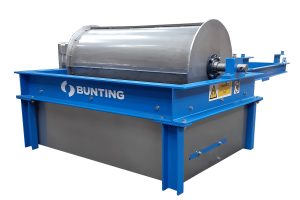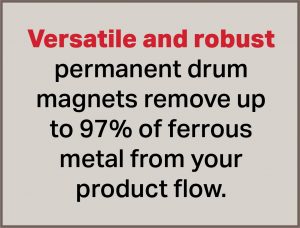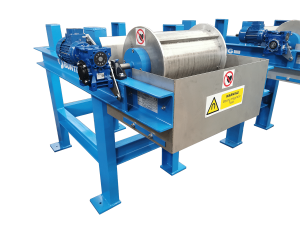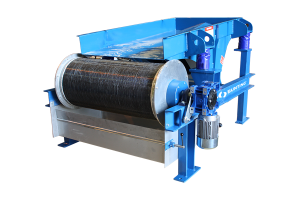Get in touch with us at our toll-free number 1-800-835-2526 or request a quote here:
Permanent Drum Magnets
Permanent Drum Magnets


Permanent drum magnets are versatile, robust magnetic separators that are well suited to a wide range of applications, including those in the food, plastics, powder and bulk, grain and milling, and metal recycling industries. They excel at separating small ferrous and paramagnetic particles from dry granular materials, in addition to being highly efficient at recovering and separating larger sized particles of ferrous metal. Permanent drum magnets are available in a wide range of diameters, feed widths, and magnetic strengths—available in standard ferrite and high-intensity rare earth. Additionally, permanent drum magnets can be constructed according to axial or radial magnetic element designs.
Permanent drum magnets provide you with high capacity processing with limited maintenance requirements.
Get a Custom Quote 

Description

The design of permanent drum magnets utilizes either adjustable 120-degree or 190-degree magnetic element arc, which is positioned inside a non-magnetic shell (often made of stainless steel). In operation, the shell rotates around the magnetic element. The rotation speed is dependent on the volume of material being processed and the diameter of the drum. To maximize the projection of magnetic strength into the product stream, magnets are mounted onto heavy-duty back plates. This significantly enhances the drum magnet’s performance. Additionally, by doing so, this reduces leakage of the magnetic field into the shaft and bearings, which in turn extends their service life.
Depending on your application, a drum magnet’s magnetic element will be constructed to produce either a radial or axial magnetic field.
Permanent drum magnets are available in many different size options, and our custom design capabilities allow you to specify your diameter and width of choice. Typically, drum magnets with smaller diameter shells (24” or less) are used to handle materials with a small particle range, whereas drum magnets with larger diameters (18” or more) are used to handle larger particles, such as bulky material in recycling applications or very high flow rate materials like grain loadouts.
A permanent drum magnet can be constructed with either fully stabilized ferrite magnets, or the highest grade of rare earth neodymium magnets.
Permanent drum magnets are frequently paired with other equipment. For example, in recycling, permanent drum magnets are placed prior to Eddy Current Separators in order to create a ferrous metal separation module. In this module, the drum magnet works to separate and recover ferrous metals, so that then the Eddy Current Separator will receive non-magnetic fraction that it can then recover non-ferrous conductive metals from. A drum magnet’s strength depends on the material it is handling, and it is important to ensure you are selecting the correct magnet strength for the materials you are handling.
Operation
 When the drum magnet is operating, first, dry materials are fed into the top of it. Typically, material is fed from a vibratory feeder in order to achieve an even and steady feed. The drum magnet’s stationary internal element creates a magnetic field, which magnetically susceptible materials are attracted to. Once attracted to the magnetic field, they are then held to the drum magnet’s rotating shell surface. Next, the revolving shell will transfer trapped magnetic particles through, then out of the internal element’s magnetic field. When material leaves the magnetic field, it is then discharged into a collection tote area or onto a receiving transfer conveyor. Non-magnetic material will not be affected, and will continue to flow under a normal trajectory.
When the drum magnet is operating, first, dry materials are fed into the top of it. Typically, material is fed from a vibratory feeder in order to achieve an even and steady feed. The drum magnet’s stationary internal element creates a magnetic field, which magnetically susceptible materials are attracted to. Once attracted to the magnetic field, they are then held to the drum magnet’s rotating shell surface. Next, the revolving shell will transfer trapped magnetic particles through, then out of the internal element’s magnetic field. When material leaves the magnetic field, it is then discharged into a collection tote area or onto a receiving transfer conveyor. Non-magnetic material will not be affected, and will continue to flow under a normal trajectory.
By placing a strategically positioned splitter between the flow of non-magnetic material and captured magnetic material, the two products are easily separated.
The magnetic element’s strength (either standard strength ferrite or high-strength rare earth neodymium) is selected based on how magnetically susceptible the material being handled is. Two magnetic element designs are available in order to suit specific separation objections:
Axial: In an axial design, polarity runs along the drum magnet’s width. This option is ideal when you are recovering ferrous material with the goal of maximizing purity and preventing non-magnetic material from being carried over into collected magnetic material. The axial field flips attracted magnetic particles as they move between fields, which allows entrapped non-magnetic material to be freed. Some would call this “alternating polarity.”
Radial: In a radial design, poles run vertically down the drum magnet. A radial design allows for the highest level of separation and/or recovery, especially when separating weakly magnetic materials. When a magnetic particle moves and is held on a vertical pole, it remains securely held on the pole until it travels underneath the drum where it then leaves the magnetic field. Some would call this “standard polarity.”
Get a Custom Quote 

Drum magnets are available in three magnetic strengths: standard, high intensity, and extreme deep reach intensity.
Standard strength: Constructed with ferrite magnets, this model is ideal for separating larger pieces of ferrous tramp metals and strongly magnetic particles. These units may be sufficient for most general ferrous separation applications.
High intensity: Constructed with rare earth magnets, this model is ideal for the separation of fine ferrous particles and weakly magnetic materials, or when you want to make absolutely sure you get as much ferrous material out as possible.
Extreme deep reach intensity: These units are designed with a high intensity field, as well as an additional deep reaching field to pull in and hold ferrous material in heavier, thicker flow streams.
Standard drum magnet diameters range from 12” to 24.” However, Bunting offers bespoke designs, and we have supplied drum magnets with diameters ranging from as small as 200mm to as large as 900mm.
Drum Housings
Drum magnets can be supplied as the drum only (so they can be incorporated into a customer’s existing machine or process), and can also be supplied in a completely enclosed housing. Bunting recommends housing when there is the need to retain dust within the system or a chance of external contamination.
Housing are also useful for keeping the material contained and to ensure the material is passed closely over the drum cover.
Housings are manufactured in robust mild steel or stainless steel depending on the magnetic field and the application. Bunting provides inspection covers, aspirators, and diverter plates standard. Bunting engineers will often work with customers to design bespoke housing to suit specific installations. Open topped housing options are available for larger bulkier materials, or where the vibratory feeder tray needs to fit down right over the top of the drum for a smoother stream transition.
Applications

Permanent drum magnets remove ferrous and weakly magnetic particles from dry non-magnetic material in many different applications and industries. They can be found in the food processing industry to remove fine metal fines out of the product stream, recycled plastic and PET industries to remove ferrous contamination, auto – electronics – rubber recycling, and mineral processing, as well as many others. We also offer the larger electromagnetic drum magnets for the Auto and Metal Recycling Industries for the larger metal fraction sizes.
Get a Custom Quote 
